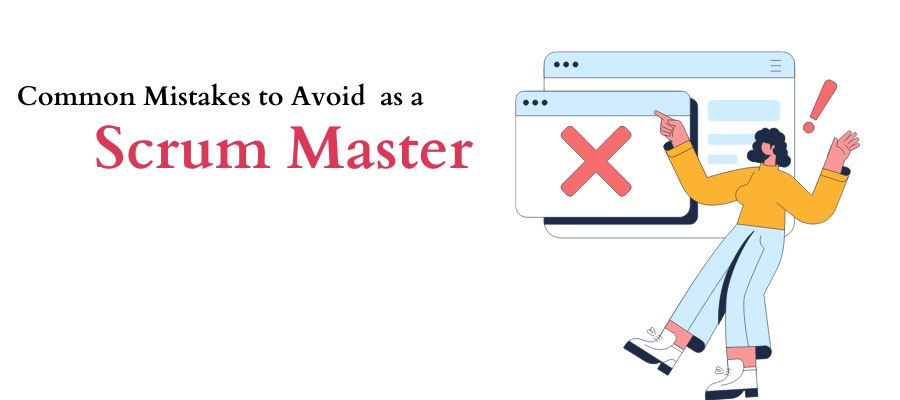Common Mistakes to Avoid as a Scrum Master

It is your role as a Scrum Master to ensure that your team follows the Scrum method, stays focused on the goals, and produces good outcomes. The position of Scrum Master is difficult and demands a great deal of effort and attention. Yet, missteps in this function are conceivable and can have a negative impact on the team and the project. In this essay, we will look at some of the most common Scrum Master mistakes to avoid.
1. Not conducting Retrospectives
Conducting Sprint Retrospective meetings is an essential part of the Scrum Events. It helps the team members identify the mistakes they made in the previous Sprint and understand how to avoid these mistakes in the upcoming Sprints. However, some Scrum Masters may feel that retrospectives are time-consuming and skip them. This must be avoided at any cost since these meetings can help the teams assess the project and improve their productivity. The Retrospectives generally have five stages: stage setting, data gathering, generating insights, deciding on actions and closing of the retrospective. Taking the time out for Retrospectives can allow the teams to review their work, take notes on completed and pending tasks and develop a continuous improvement plan.
2. Ineffective everyday Scrum meetings
Daily Scrum Meetings are essential to the Scrum process and must be conducted properly. It helps the team members stay connected with each other and understand the progress of the project. The Scrum Master is responsible for facilitating these meetings and ensuring they are conducted on time. These meetings should not exceed 15 minutes and should focus on the project's progress. The discussions should be structured and aimed at bringing more transparency and visibility into the project. Not having proper or lax daily stand-ups will hamper the project's progress and hinder collaboration and communication between the team members.
3. Scrum Master operating as a mediator
The role of a Scrum Master is to act as a servant leader and be a part of the team. Acting as a mediator between the Product Owner and the Developer may have a negative impact on the scrum process. It can lead to delays in the development process, as the Scrum Master may not always be available. Additionally, communication can be lost as the Scrum Master may not understand what the team member has asked for and communicate it properly. For these reasons, it is recommended that the Scrum Master not become a bridge between the PO and the team but instead encourages direct communication and collaboration among the members. This will ensure that the team works self-organizing and does not need the help of the Scrum Master most of the time. In this way, the Scrum Master can help to reduce the gap between the PO and the team and create a more efficient scrum environment.
4. Becoming the team's assistant
Being the team's assistant, a Scrum Master should not just help the other members when they require it but also guide them in the right direction to become a self-organized team. Taking ownership of their actions and solving the complexities on their own builds up the team's confidence. A Scrum Master should act as a mentor and create awareness among the team members regarding the anticipation and resolution of the problems. This would enable the team to take full responsibility for their actions, and their confidence in the scrum process would grow. The Scrum Master should constantly encourage and motivate the members to solve the problems by themselves and aim to make the team a self-organizing one in the long run.
5. Scrum Master is responsible for everything
Product delivery is the Scrum Master's job in Scrum methodology, which is a shift from the traditional command and control approach. The Scrum Master, however, shouldn't take all the responsibility for the product's on-time arrival. Each member of the Scrum Team must feel that their efforts directly affect the quality and timeliness of the final result. In this approach, the entire team can be held responsible for the final result since everyone will be invested in its success. The Scrum Master must also ensure that everyone is on the same page and knows how crucial their role is to the project's overall success. This will lead to successful product delivery and a satisfied customer.
6. Not building obstacles in the early stages
The Scrum Master's job is to eliminate obstacles that may slow the team's progress. But, one of the most frequent blunders is to put off dealing with a problem until it has become a major one. Because of this, product delivery times may increase while quality declines. The Scrum Master should find problems before the team starts working on them. The team should be encouraged to raise any potential roadblocks to their progress during the Daily Stand-ups.
Conclusion
Scrum Master is one of the most crucial roles in any software development project. The Scrum Master is responsible for ensuring that the project is successful, the team is focused, and the goals are met on time. Considering the importance of the job, errors in the function of Scrum Master are widespread. Scrum Masters may guarantee that they are executing their work effectively and assisting the team in achieving success by avoiding the typical pitfalls highlighted above.
Reference
- https://www.tothenew.com/blog/10-common-scrum-mistakes-and-how-to-avoid/



